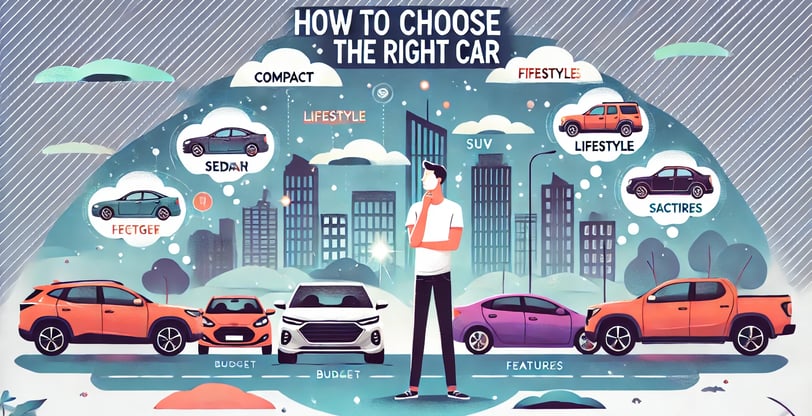How to Choose the Right Car for Your Lifestyle
I still remember the day my parents let me take their car out for my first solo drive. It was a small hatchback, perfect for city commutes but not exactly my dream ride. As I sat in the driver’s seat, fiddling with the rearview mirror and feeling a mix of excitement and anxiety, a thought struck me: "If I could choose my own car, what would it be?" Now, years later, as a university student juggling academics, internships, and weekend road trips, I’ve learned that choosing the right car isn’t just about aesthetics or speed. It’s about matching the car to your life.
Laksh Rathore
11/29/20243 min read


Introduction: The First Drive Dilemma
I still remember the day my parents let me take their car out for my first solo drive. It was a small hatchback, perfect for city commutes but not exactly my dream ride. As I adjusted the rearview mirror, a mix of excitement and anxiety rushed through me. "If I could choose my own car, what would it be?" This question lingered for years until I started university and began juggling academics, internships, and weekend road trips. Choosing the right car isn’t just about aesthetics or speed—it’s about how it fits into your life. Let me share lessons I’ve learned, mistakes I’ve made, and tips to save you time, money, and headaches.
1. Define Your Lifestyle: The Starting Line
The first step in choosing the right car is understanding your lifestyle. What does your typical day look like? Are you commuting in city traffic, taking road trips, or needing space for friends and family?
My Experience
During college, public transport worked fine—until I got an internship across the city. I needed a car that could handle heavy traffic and long-distance drives. A fuel-efficient sedan seemed ideal, but I realized I also needed trunk space for groceries and my bags.
What Research Says
According to a report by Kelley Blue Book, over 60% of buyers prioritize practicality over luxury. Factors like fuel efficiency, maintenance, and interior space often outweigh flashy features.
My Takeaway
Think about your day-to-day life:
Urban Commuter? Compact cars offer easy parking and good mileage.
Family Person? SUVs provide more seating and cargo space.
Adventurer? All-terrain vehicles might suit you better.
Your lifestyle is your compass; let it guide your choice.
2. Set Your Budget: Dream Big, Spend Smart
We all have dream cars (mine’s a Tesla), but budget plays a major role in making a smart choice.
My Experience
When I first browsed cars, I was tempted by premium models. Reality hit when I factored in insurance, fuel, maintenance, and registration. I chose a reliable used car that fit my budget and avoided heavy depreciation costs.
What Research Says
Edmunds.com advises spending no more than 15% of your monthly income on car payments. For students or first-time buyers, used cars often provide great value without breaking the bank.
My Takeaway
Define your budget, and include all costs:
Sticker price
Insurance
Fuel and maintenance
If you’re considering a used car, get it inspected. A little caution can save you from big regrets later.
3. Prioritize Features That Matter to You
Every car comes with a list of features—some essential, others just cool. Focus on what truly matters to you.
My Experience
I was drawn to models with fancy touchscreens and sound systems but realized safety features were more critical. I chose reliability over luxury.
What Research Says
Consumer Reports suggests prioritizing essentials like anti-lock braking systems (ABS), airbags, and backup cameras over luxury add-ons. Fuel efficiency and reliability often rank highest for most buyers.
My Takeaway
Create a list of:
Must-Haves: Fuel efficiency, good mileage, safety features.
Nice-to-Haves: Sunroof, leather seats, advanced infotainment.
Stick to your priorities, and don’t let flashy ads or sales tactics sway you.
4. Test Drive: The Moment of Truth
A car might look perfect on paper, but how does it feel on the road? Test-driving is crucial.
My Experience
When I test-drove my first car, I noticed things I hadn’t considered: seat height, steering responsiveness, and even engine noise. Some cars I loved online felt uncomfortable in reality, while others clicked instantly.
What Research Says
Experts at AutoTrader recommend test-driving at least 3–4 cars. Drive them in varied conditions—city streets, highways, and uneven roads—to gauge performance.
My Takeaway
Never skip the test drive. It’s like meeting someone from a dating app—you need to see if the chemistry is there in real life.
Conclusion: Your Car, Your Story
Choosing the right car isn’t just about specs or features—it’s about finding a vehicle that fits your life, supports your goals, and makes you happy every time you drive it. My modest hatchback has become a reliable partner on my university journey, and I wouldn’t trade it for anything (except maybe that Tesla someday).
Take your time, do your research, and trust your instincts. Your perfect car is out there, waiting to become a part of your story. Happy car hunting!
